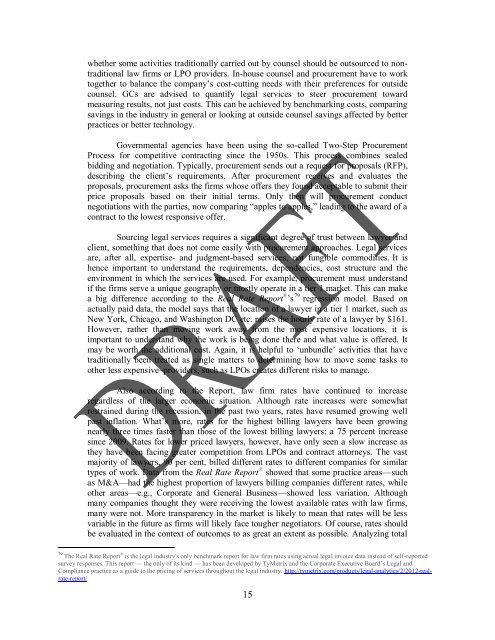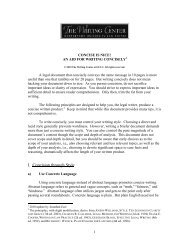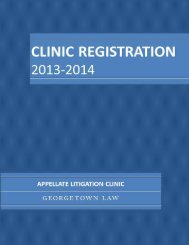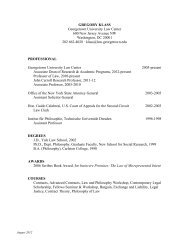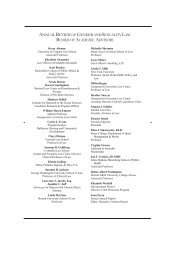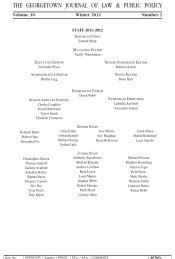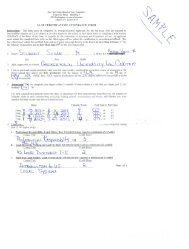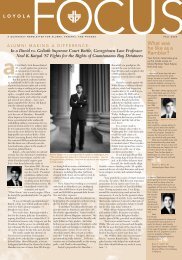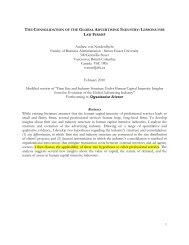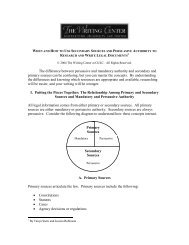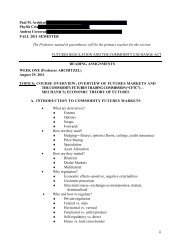Date: April 12, 2013 Topic: The Shrinking ... - Georgetown Law
Date: April 12, 2013 Topic: The Shrinking ... - Georgetown Law
Date: April 12, 2013 Topic: The Shrinking ... - Georgetown Law
Create successful ePaper yourself
Turn your PDF publications into a flip-book with our unique Google optimized e-Paper software.
whether some activities traditionally carried out by counsel should be outsourced to nontraditional<br />
law firms or LPO providers. In-house counsel and procurement have to work<br />
together to balance the company’s cost-cutting needs with their preferences for outside<br />
counsel. GCs are advised to quantify legal services to steer procurement toward<br />
measuring results, not just costs. This can be achieved by benchmarking costs, comparing<br />
savings in the industry in general or looking at outside counsel savings affected by better<br />
practices or better technology.<br />
Governmental agencies have been using the so-called Two-Step Procurement<br />
Process for competitive contracting since the 1950s. This process combines sealed<br />
bidding and negotiation. Typically, procurement sends out a request for proposals (RFP),<br />
describing the client’s requirements. After procurement receives and evaluates the<br />
proposals, procurement asks the firms whose offers they found acceptable to submit their<br />
price proposals based on their initial terms. Only then will procurement conduct<br />
negotiations with the parties, now comparing “apples to apples,” leading to the award of a<br />
contract to the lowest responsive offer.<br />
Sourcing legal services requires a significant degree of trust between lawyer and<br />
client, something that does not come easily with procurement approaches. Legal services<br />
are, after all, expertise- and judgment-based services, not fungible commodities. It is<br />
hence important to understand the requirements, dependencies, cost structure and the<br />
environment in which the services are used. For example, procurement must understand<br />
if the firms serve a unique geography or mostly operate in a tier 1 market. This can make<br />
a big difference according to the Real Rate Report ® ’s 79 regression model. Based on<br />
actually paid data, the model says that the location of a lawyer in a tier 1 market, such as<br />
New York, Chicago, and Washington DC etc. raises the hourly rate of a lawyer by $161.<br />
However, rather than moving work away from the most expensive locations, it is<br />
important to understand why the work is being done there and what value is offered. It<br />
may be worth the additional cost. Again, it is helpful to ‘unbundle’ activities that have<br />
traditionally been treated as single matters to determining how to move some tasks to<br />
other less expensive–providers, such as LPOs creates different risks to manage.<br />
Also according to the Report, law firm rates have continued to increase<br />
regardless of the larger economic situation. Although rate increases were somewhat<br />
restrained during the recession, in the past two years, rates have resumed growing well<br />
past inflation. What’s more, rates for the highest billing lawyers have been growing<br />
nearly three times faster than those of the lowest billing lawyers: a 75 percent increase<br />
since 2009. Rates for lower priced lawyers, however, have only seen a slow increase as<br />
they have been facing greater competition from LPOs and contract attorneys. <strong>The</strong> vast<br />
majority of lawyers, 90 per cent, billed different rates to different companies for similar<br />
types of work. Data from the Real Rate Report ® showed that some practice areas—such<br />
as M&A—had the highest proportion of lawyers billing companies different rates, while<br />
other areas—e.g., Corporate and General Business—showed less variation. Although<br />
many companies thought they were receiving the lowest available rates with law firms,<br />
many were not. More transparency in the market is likely to mean that rates will be less<br />
variable in the future as firms will likely face tougher negotiators. Of course, rates should<br />
be evaluated in the context of outcomes to as great an extent as possible. Analyzing total<br />
79 <strong>The</strong> Real Rate Report ® is the legal industry's only benchmark report for law firm rates using actual legal invoice data instead of self-reported<br />
survey responses. This report — the only of its kind — has been developed by TyMetrix and the Corporate Executive Board’s Legal and<br />
Compliance practice as a guide to the pricing of services throughout the legal industry. http://tymetrix.com/products/legal-analytics/2/20<strong>12</strong>-realrate-report/<br />
15


